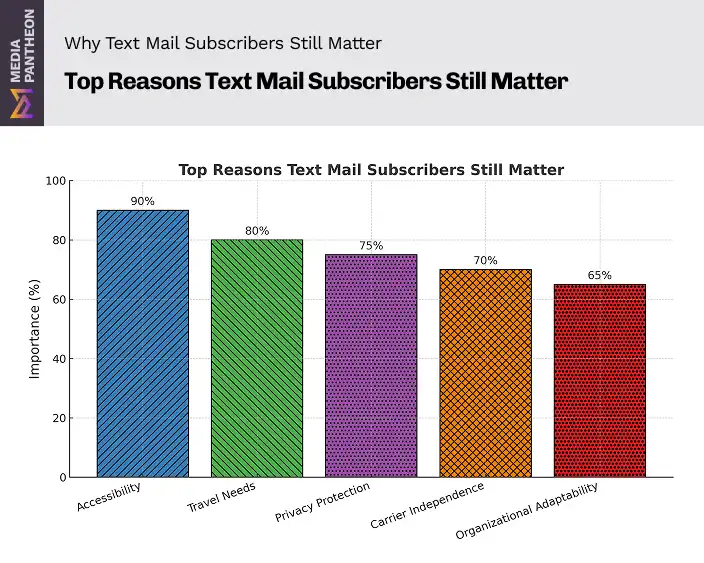Home Media Pantheon Blog What Is a Text Mail Subscriber? Everything You Should Know
Table of Contents


Foued
15 MIN READ
In today’s fast-moving world, text messages have become a trusted way to share information quickly. People use them for confirmations, security codes, updates, and alerts because they are simple, direct, and familiar.
Most of the time, a text arrives within seconds. The phone buzzes, the notification appears, and the conversation moves forward without delay. Yet there are moments when the expected reply never comes, leaving the sender confused and unsure if the message was even seen.
This gap in communication is not always caused by bad signal, outdated devices, or human error. In many cases, the reason is linked to the type of phone number being contacted. Not all numbers work the same way when it comes to sending and receiving messages.
Some are connected to mobile networks, others to landlines, and a growing number operate entirely online. Each method has its own process, and that process can change how messages are handled from start to finish.
To truly understand these differences, we first need to look closely at a type of number that is becoming more common yet still unfamiliar to many people.
A text mail subscriber is a person who sends or receives messages using an internet-based number from a VoIP service, allowing text communication without a mobile carrier, SIM card, or revealing their personal phone number, while offering privacy and flexibility.
These numbers are assigned by Voice over Internet Protocol (VoIP) providers such as Google Voice, TextNow, and TextFree. Unlike traditional mobile numbers that route texts through cell towers, these services transmit and store messages on the provider’s servers until the recipient accesses them.
Access can be gained through a mobile app, a desktop application, or a web browser. Because the number is not tied to a physical SIM card or a single device, users can send and receive messages from multiple devices anywhere there is internet access.
This setup allows for flexible communication and helps protect personal phone numbers from exposure in public or temporary interactions. However, the reliance on internet access means that if the user is offline, messages will not appear until they reconnect and check their account.
In some cases, this delay can be hours or even days, depending on how often the account is accessed. While this can be inconvenient for urgent matters, it is perfectly functional for casual or non-time-sensitive communication.
Understanding what a text mail subscriber is provides the foundation for exploring why this type of number has become increasingly popular in both personal and professional communication.
People use text mail subscriber numbers to communicate through internet-based services instead of mobile carriers, reducing costs, protecting personal phone numbers, and allowing flexible access from multiple devices with only an internet connection.
These benefits become clear when looking at the main reasons people choose text mail subscriber numbers. From affordability to flexibility, each factor highlights why they have become a popular choice for modern communication.
By looking at these advantages together, it is clear that text mail subscriber numbers fill a unique role in modern communication. They are chosen not only for what they offer but also for when they can be used most effectively, which is the focus of the next section.
Text mail subscriber numbers are often used in situations where communication needs to be controlled, temporary, or flexible, such as online transactions, seasonal projects, travel arrangements, or events that require selective availability.
Unlike standard mobile numbers that remain active at all times, text mail subscriber numbers depend on internet connectivity. This means they are usually used when the person is online and ready to respond, such as during work hours, travel downtime, or specific project periods.
They are a common choice for temporary interactions. For example, someone might use one to coordinate the sale of an item online, manage customer inquiries during a short-term business campaign, or stay connected while studying abroad. Once the purpose is fulfilled, the number can be deleted without long-term consequences.
These numbers also work well for situations where a separate communication channel is helpful. A contractor might use one to keep business conversations apart from personal texts, or a volunteer team could share a single account to manage messages for an event.
Below is a breakdown of common contexts, why a text mail subscriber is chosen, and how long it is typically kept active:
| Context | Why It’s Chosen | Typical Duration |
| Project-based work | Keeps work contact separate | Weeks to months |
| Seasonal operations | Handles peak customer inquiries | Seasonal periods |
| Travel abroad | Avoids roaming fees while maintaining local access | Trip duration |
| Online market sales | Protects personal details until deal completion | Days to weeks |
| Temporary registrations | Provides verification without long-term use | Minutes to days |
These patterns reveal that timing plays a central role in why people choose this option. Knowing the situations in which these numbers appear also makes it easier to identify where they are most often found.
Text mail subscriber numbers are most often seen in online spaces where privacy, temporary use, or cost savings are valued. They appear in digital marketplaces, short-term registrations, travel-related communications, and professional situations requiring a separate contact channel.
Many online classified sites and peer-to-peer sales platforms contain these numbers. Sellers and buyers often use them to protect personal phone numbers while keeping conversations open until a transaction is complete. Once the deal is done, the number can be deactivated with no lasting impact.
They are also used in professional environments where work and personal communication need to remain separate. Seasonal businesses, temporary project teams, or event organizers may issue text mail subscriber numbers for a specific period to keep operations organized.
Travel is another common reason these numbers appear. People staying abroad may use them to avoid high roaming fees while maintaining a local point of contact. This can be useful for tourists, students, or remote workers spending extended time in another country.
Below is a summary of common places and the reasons these numbers are often used there:
| Location or Platform | Why It’s Found There |
| Online marketplaces | Keeps buyer and seller information private |
| Classified ad sites | Protects identity during public listings |
| Short-term employment | Separates business communication from personal use |
| Travel bookings | Avoids roaming fees while staying reachable |
| Temporary registrations | Quick verification without long-term obligation |
Recognizing where these numbers are likely to be found can make it easier to prepare for how communication will work. This naturally leads into how to identify when a number belongs to a text mail subscriber.
A text mail subscriber can often be identified by reverse phone searches, carrier lookup tools, and patterns like delayed responses or replies that only appear when the user is online.
These numbers are not tied to mobile networks. They behave differently from cell numbers, with messages arriving only when the recipient is connected to the internet. Calls may also go directly to voicemail if no active connection exists.
For example, if you send a message midday and always get replies hours later only after the user logs in, it suggests the number is internet-based rather than a standard mobile line.
Carrier lookup services are another reliable method. These tools reveal whether a number belongs to a mobile carrier, landline, or VoIP service.
For instance, a lookup may return “Provider: Bandwidth.com (VoIP)” instead of “Verizon Wireless.” Seeing a VoIP provider is often a strong sign the number is a text mail subscriber.
Behavioral patterns also help. Many of these numbers are temporary, active only for projects or sales, and abandoned once the purpose is complete.
They often show up in classified ads, short-term registrations, or situations where people prefer anonymity.
To make these indicators easier to evaluate, the table below summarizes the most common methods of identifying a text mail subscriber and the specific signs to look for.
| Method | What to Look For |
| Reverse phone lookup | Carrier type listed as VoIP |
| Message timing | Replies only when user is online |
| Call behavior | Calls go to voicemail without ringing |
| Usage context | Temporary or anonymous interactions |
| Carrier information | Shows internet-based service in results |
This table highlights the main red flags that separate text mail subscriber numbers from standard mobile lines. By comparing these signs together, it becomes clearer when a number is VoIP-based and temporary.
Understanding these signs makes it easier to confirm the type of number you are contacting, which is important before exploring how these numbers function behind the scenes.
Text mail subscriber numbers send and receive messages through internet-based VoIP platforms instead of mobile carrier networks. Messages are stored on the provider’s server until the recipient retrieves them using an app or browser.
The provider’s server acts as an intermediary between the sender and recipient. This additional step changes the delivery speed and reliability compared to standard texting, which moves messages directly through carrier systems.
If the recipient is offline, has notifications turned off, or does not check their VoIP account regularly, messages may remain unread for hours or even days. Replies follow the same indirect path, traveling from the recipient’s app to the VoIP server, then to the sender’s carrier before reaching the sender’s device.
Understanding how a message travels to a text mail subscriber helps explain why delays or missed notifications are common. Each stage in the process, from the initial send to final delivery through a VoIP app, affects speed, reliability, and overall user experience.
The process starts when you compose a text on your phone or SMS platform. This could be a confirmation code, delivery alert, appointment reminder, or promotional message.
Once you hit send, the message is transmitted through your mobile carrier’s network. At this stage, it behaves like any standard SMS and is ready to be passed toward its destination.
If the number is assigned to a VoIP service, the message bypasses mobile network towers completely. Instead, it is directed to the VoIP provider’s server for storage.
The server holds the message until the recipient’s device connects to the internet. If the person is offline or in an area without access, the message waits on the server.
When the recipient goes online, they can access the stored message through a VoIP app or a browser-based inbox linked to their account. This step requires them to open the platform.
If the app is closed, notifications are off, or the account is rarely checked, the message can remain unread for hours or even days. This is the point where most delivery delays occur.
This chain of events shows how every stage influences message speed and reliability, setting the stage for why text mail subscribers continue to play a role in today’s communication landscape.
Text mail subscriber numbers remain relevant because internet-based communication is becoming a larger part of daily life. They offer a flexible, cost-effective way to stay connected without relying on a traditional mobile network.
The bar chart below highlights the top five reasons these numbers continue to be used. Accessibility is the leading factor, followed by travel needs, privacy protection, carrier independence, and organizational adaptability.

These results show the most common motivations for using text mail subscriber numbers. The following points break down each reason to explain why it continues to be relevant today.
Accessibility stands out because a VoIP-based number can be created instantly, often at no cost, and used across multiple devices. This benefits those without SIM cards or living in areas with poor mobile coverage but reliable internet.
Travel needs are also a strong driver. These numbers provide a local presence abroad without the expense of roaming fees, enabling affordable communication from anywhere with Wi-Fi.
Privacy protection is another core reason. Using a separate number keeps personal phone details out of public spaces, reducing exposure to spam and fraud attempts.
Carrier independence ensures communication continues in areas with weak mobile signals, as long as there is an internet connection. Organizational adaptability allows businesses to adjust contact methods for customers using these numbers.
These combined advantages explain why text mail subscribers remain a trusted tool, which makes it equally important to understand the risks and security concerns that accompany their use.
Text mail subscriber numbers can be misused for fraud, spam, phishing, and delays in message delivery. Their anonymity makes them harder to trace, creating security challenges for both individuals and organizations.
Text mail subscriber numbers provide flexibility but also introduce risks. The anonymity that protects users’ privacy can also give malicious actors a shield against accountability.
These risks appear in several common forms that affect both individual users and organizations:
These risks highlight the need for proactive safety measures. The next section will outline practical steps that individuals and organizations can take to reduce exposure to these threats and maintain secure communication practices.
Taking proactive safety steps when using or interacting with text mail subscriber numbers reduces the chances of falling victim to fraud, spam, or phishing and helps ensure important messages are received securely.
A structured approach to security makes it easier to identify threats and respond effectively.
Below is a table that lists practical actions both individuals and organizations can take.
| Safety Measure | Description |
| Verify the sender’s identity | Confirm the source through official channels before responding to messages. |
| Avoid clicking unknown links | Do not open links from unverified senders to prevent phishing or malware. |
| Use spam filters and caller ID | Enable tools that identify and block suspicious numbers or messages. |
| Limit sharing of personal info | Share sensitive details only with trusted and verified contacts. |
| Keep communication records | Save logs and screenshots to assist with reporting incidents. |
| Report suspicious numbers | Notify your service provider or relevant authorities about suspicious use. |
These measures offer clear and actionable ways to reduce exposure to common threats. They are easy to implement and significantly improve safety when sending or receiving messages through text mail subscriber numbers.
With strong safety habits in place, users can enjoy the benefits of text mail subscriber numbers while minimizing the risks, leading into the final section that will summarize the key points covered in this guide.
A text mail subscriber is someone who sends or receives messages through an internet-based number provided by a VoIP service, enabling text communication without a SIM card or mobile carrier and maintaining privacy while allowing flexible access across devices.
These numbers have become an established part of modern communication because they combine convenience with security. Their ability to function without traditional carrier infrastructure gives users more control over how and where they communicate, whether for work, travel, or personal use.
By understanding how text mail subscribers operate and the scenarios in which they are most effective, you can choose the best way to integrate them into your communication strategy. Pairing their advantages with proactive safety habits ensures you enjoy the benefits without compromising reliability or privacy.
As internet-based messaging continues to grow, text mail subscriber numbers will remain a valuable tool for staying connected. Using them thoughtfully means they can enhance your reach, protect your information, and adapt to the way you prefer to communicate.
About Foued
Foued is the CEO of Media Pantheon, Inc., a full-stack developer, web accessibility expert, and the technical lead behind 1,000+ website builds worldwide. Fluent in English, German, French, and Arabic, he and his team deliver fast, secure, and scalable digital experiences engineered for long-term growth.


Our Work, Your Inspiration
Suggested Blogs
Explore the projects that showcase our expertise and creativity. From innovative designs to robust functionalities, our portfolio reflects the success
Get Started